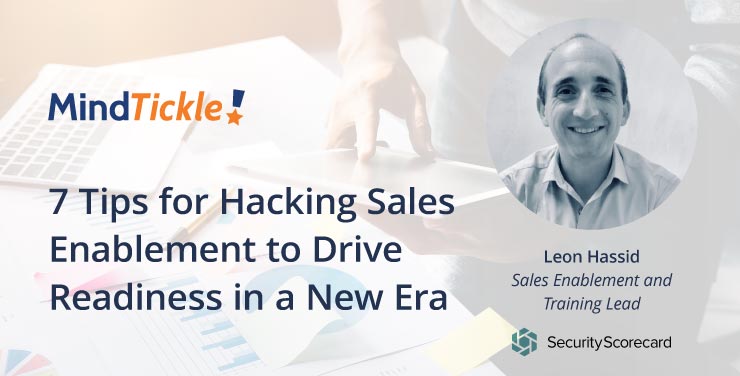A lot has changed since March — the way we interact, the way we work, the way we live. But as a SaaS-based company with high growth and high sales velocity, Security Scorecard’s goals are one thing that hasn’t changed. Rather, what’s changed are the tactics we use to achieve our goals.
Now more than ever, sales organizations need smart and practical engagement, which probably looks a little different than it did at the beginning of the year. New tactics to ensure sales readiness must take into account the digital nature of our work world, where in-person interaction is now the exception rather than the rule. For the foreseeable future, leads no longer come in via live events, sales kickoffs are experienced through a screen, bootcamps and on-boarding new talent take place over video, and training and coaching are done virtually.
Faced with this, there are some hacks that sales reps and enablement leaders can employ to navigate these new challenges and stay engaged and connected — with each other, their larger teams and the customer.
Master the all-important virtual meeting. Aside from being familiar with the features and functionality of videoconferencing tools like Zoom, sales reps and leaders alike must ensure they have reliable internet service, quality headsets and a proper background to make remote communications as seamless as possible. This is especially important with customer meetings, as distractions and technology hiccups can negatively impact the flow of the conversation.
Maintain clear communication and coaching. Clear communication is absolutely critical now so that sales reps are aligned and don’t feel like they’re operating in a vacuum. Sales and enablement leaders can help by keeping their team informed about the company’s approach to the new normal, new messaging and training. In addition, boost morale by recognizing accomplishments, whether in one-on-one meetings or in a virtual group setting.
Align with marketing. Collaboration between sales and marketing hasn’t always been easy, but it’s more important now than ever. By working more closely together, sales can benefit from open lines of communication with customers across all digital channels to find and nurture leads and tie into the marketing side of the sale cycle.
Support sales with technology. It’s imperative to support sales and keep remote workers connected with technology. For example, at Security Scorecard, we use Slack to send out daily selling tips, a new piece of content or a new top track that a sales rep used to communicate ROI. We also use technology to record sales conversations to help with on-boarding and training, and Mindtickle to reinforce reps’ product knowledge with continuous learning, refresh messaging and re-certify through virtual role play and assessments. And short training videos — maybe three to five minutes long — are perfect for driving home new tips and information that help the sales rep be successful.
Engage with the customer in the context of the new world. More than ever, it’s critical for sales reps to understand that the customer is going through their own unique situation, and the sales rep must be empathetic to that. Messaging should be very deliberate and delivered in a way that keeps in mind the customer’s own circumstances: Perhaps their budget has been cut or they’re working from home; maybe they’ve been told to go through a risk exercise. In short, time saved by not traveling to meet a customer in person should be spent on building relationships against the backdrop of this new normal.
Keep an eye on data, metrics and feedback to determine where sales enablement can boost sales velocity. Clearly, sales enablement can’t expect that tactics and strategies that worked before will work now to generate higher sales velocity. But determining what, exactly, to tweak is difficult to pinpoint without the insight gleaned from data, metrics and even the minds of those in the trenches. Start by tracking the four factors affecting sales velocity using this equation:
number of opportunities in the pipeline x average deal size x win rate
————————————————————————
sales cycle
The resulting value is the amount of money coming into the company on any given day or month. Tracking this number over time can help optimize sales processes and tactics, and highlight what kinds of enablement programs can have an impact. Outside of hard numbers, sales enablement leaders can also tap into the reps themselves. Surveys or polls can yield insight that helps fine tune sales enablement programs so that they work for more reps, more often.
Plan for the future. Engage with marketing and the entire sales organization to determine how enablement programs and strategy should be adjusted for the future. Explore how the market opportunity has changed and how to optimize account plans for new market opportunities. Reps can provide insight into how demand has changed in their territory, what the most frequent objections are, which channels perform best and the ideal customer profile. External information, such as from market research firms and investment banks, can also yield information to help companies plan for the future.
As we move forward, sales enablement leaders must prepare for more of the same. Taking time to optimize training and materials so that they work for a remote workforce and finding new ways to communicate and engage with the team and customer are critical if sales organizations are to continue to come out on top in our new normal.
For more information, check out my webinar, Sales Enablement Hacks: Keeping Remote Sales Teams from Falling Asleep Into the Next Normal.



 By Vivian Batman
By Vivian Batman
 By Rahul Mathew
By Rahul Mathew
 By Aman Bafna
By Aman Bafna